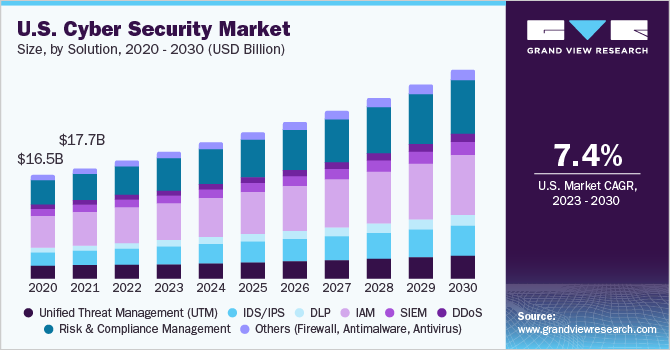Cyber Security Market 2030 - Advanced Solutions for Modern Businesses
Data breaches, malware, and hacking attempts are all too common, forcing businesses and individuals to prioritize cybersecurity market trends. The internet has become an essential part of our lives, and with it comes the ever-present threat of cyberattacks. Within the struggles of integrity, privacy, and trust, the domain of cybersecurity thrives with firewalls, encryption keys, and neural networks that safeguard our interconnected existence.

The Market Landscape
This blog explains the core of the cybersecurity market, examining its growth, challenges, and the valiant defenders who shield the virtual world.
Numbers Beyond 0 & 1: The global cyber security market is no mere niche; it’s a thriving ecosystem fueled by relentless innovation and escalating threats. According to recent reports, here are the key figures:
- In 2023, the market was estimated at a staggering USD 222.66 billion, growing at a projected compound annual growth rate of 12.3% from 2024 to 2030.
- By 2030, the market is expected to reach new heights, safeguarding digital assets worth billions.
Catalysts of Growth: Exploring what drives the market in an upward trajectory
- Coping with Cyber-attacks: The relentless onslaught of cyber-attacks—whether from state-sponsored actors, criminal syndicates, or lone hackers—fuels the demand for robust security solutions. Breaches compromise sensitive data, disrupt services, and erode trust.
- Regulatory Compliance: Governments worldwide are enacting stricter data protection regulations, mandating businesses to implement strong cybersecurity measures.
- IoT and Smart Devices: Homes, cars, and even refrigerators are now part of the Internet of Things (IoT). With great convenience comes great vulnerability. Cyber security must adapt to protect these interconnected devices.
- AI and Cloud: The rise of artificial intelligence (AI) and cloud computing reshapes the battlefield. AI-powered threat detection, predictive analytics, and adaptive defenses are the new weapons.
- Increased Awareness: Businesses and consumers are becoming more aware of cybersecurity risks, leading to a greater demand for security solutions.
- Changing Work Landscape: Remote work, choose-your-own-device (CYOD), and bring-your-own-device (BYOD) models blur the lines between personal and corporate networks. Traditional defenses struggle: advanced solutions are the need of the hour.
Cyber security Innovators: In this digital saga, companies and researchers don their capes. A few instances of these are given below:
- Symantec’s Adaptive Protection: Powered by machine learning (ML), this solution customizes endpoint security, saving costs while thwarting attacks.
- AI in Cyber Security: AI algorithms learn from patterns, detect anomalies, and predict threats. The battle is no longer human vs. machine; it’s human with machine.
- Edge Computing: As data processing moves closer to the source (the edge), security adapts. Real-time threat detection becomes feasible.
Conclusion
The cyber security market isn’t just about firewalls and antivirus software; it’s about resilience, adaptability, and a commitment to safeguarding digital existence. By understanding the factors driving the market growth and the different segments of the market, businesses and individuals can make informed decisions about their cybersecurity needs. Investing in cybersecurity is no longer optional; it's essential for protecting our digital assets and infrastructure in an increasingly interconnected world.
Comments
Post a Comment